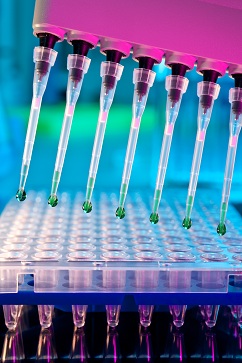The pan-European project decoding the DNA

Related topics
Health Innovation Health, Demographic Change and Wellbeing Nanotechnologies Germany Ireland United Kingdom Switzerland Israel Serbiadate: 13/02/2014
Project: NanoTools for ultra fast DNA sequencing
acronym: NANODNASEQUENCING
See also: CORDIS
Contact: www.nanodnasequencing.org/
The researchers found that nucleotide bases - adenine, guanine, cytosine and thymine - conduct electricity at a voltage of about 2V. So they designed a gene sequencing tool that sends electrical charges onto the DNA as it passes through a tiny hole, a nanopore with integrated nanotube side-electrodes. That charge then reveals the order in which the nucleotides occur on a strand of DNA. The new approach has the potential of sequencing one million base pairs per minute, which means that the entire human genome – some three billion base pairs - could be sequenced in only a few hours.
The coordinator of the NanoDNAsequencing project, Radomir Žikić, a professor at the Institute of Physics in Belgrade, Serbia, describes the project as a revolutionary leap on from the Human Genome Project, in which sequencing took about 10 years. “Scientifically, this will be a massive breakthrough in modern medicine and could potentially save a significant number of lives,” he says. “Doctors will be able to use this crucial information to diagnose and treat patients based on their own unique DNA structure,” he explains.
The researchers have already filed a patent for the construction of a sub-nanometre junction-gate device for the single molecule electrical characterisation and DNA sequencing. Another highlight of the project was the simultaneous calculation of two core measures of the proposed sequencing technology: the ionic blockade current and the transverse electrical current.
However, Žikić says the bigger scientific prize is learning about our health. “We can uncover our predetermined future from the map of the DNA,” he says. “Just imagine if you could have your DNA ‘read’ when you are a teenager to inform you that you are predisposed to Alzheimer’s disease. You would have the proper notice and could start treatment at an early stage. You would have the opportunity to extend your life and possibly cure the disease altogether,” adds Žikić.
Žikić says the link between disease and genetics is so powerful that the implications could be a new approach to medicine. “It could completely alleviate some of the diseases and other ailments that are causing so much suffering around the world,” he concludes.